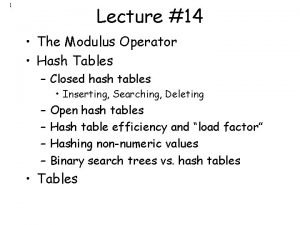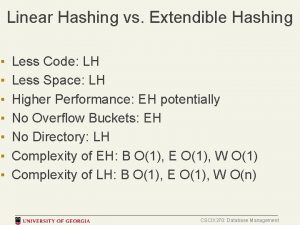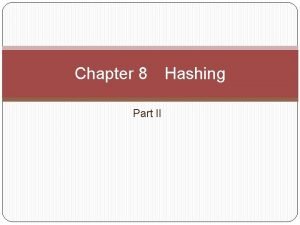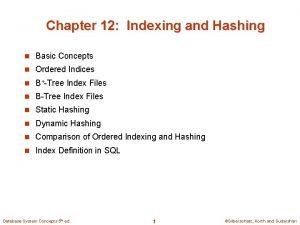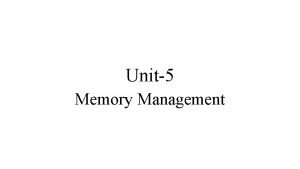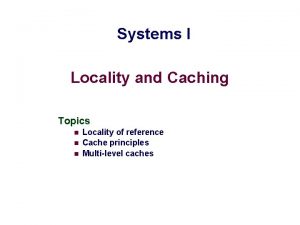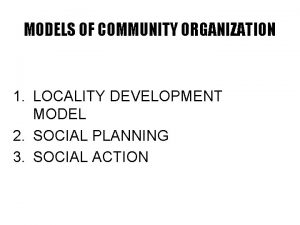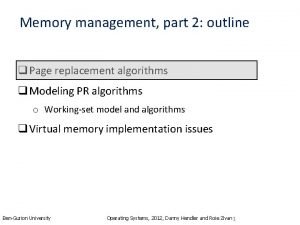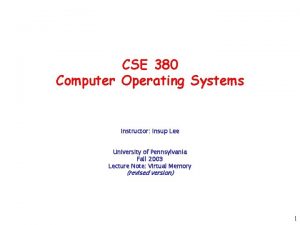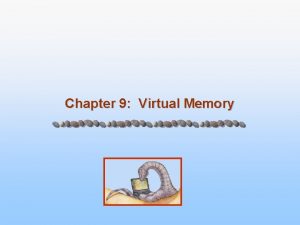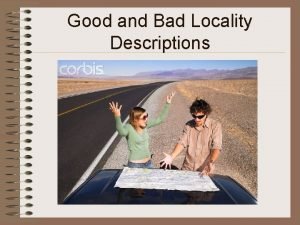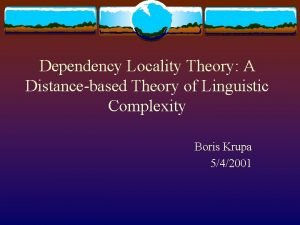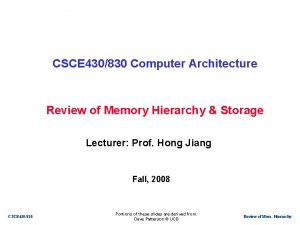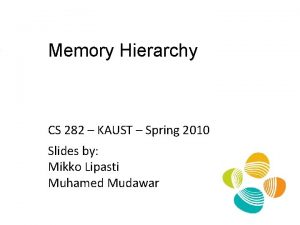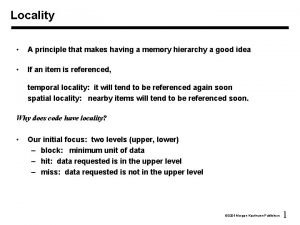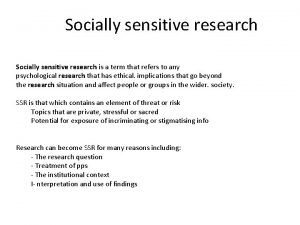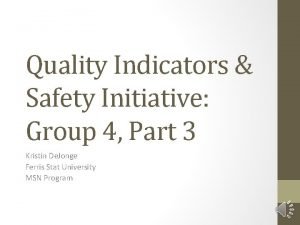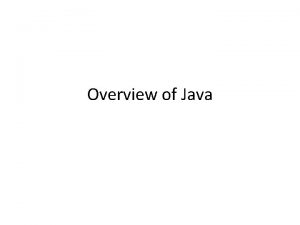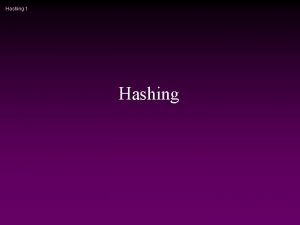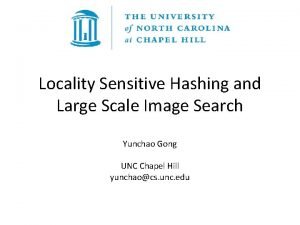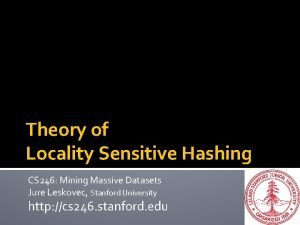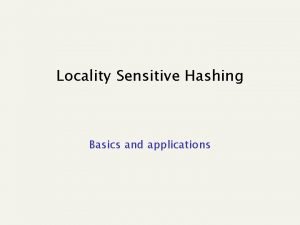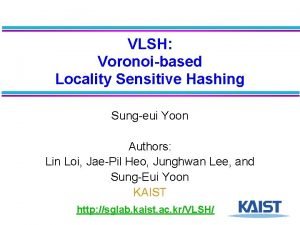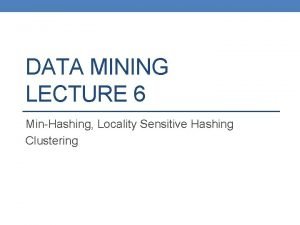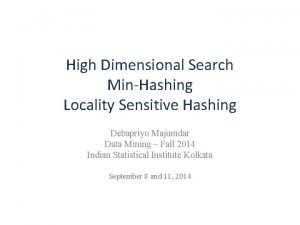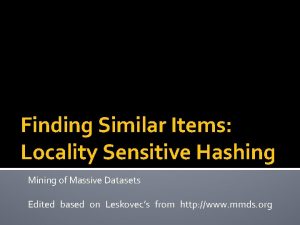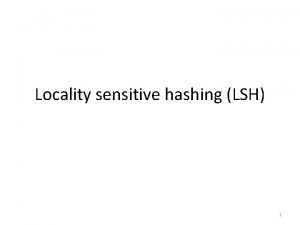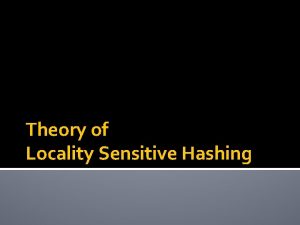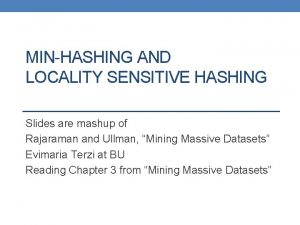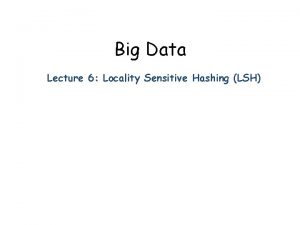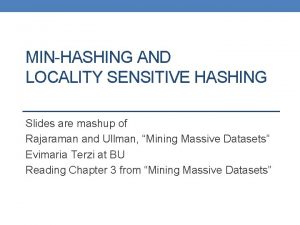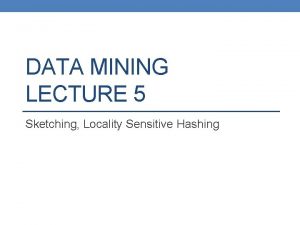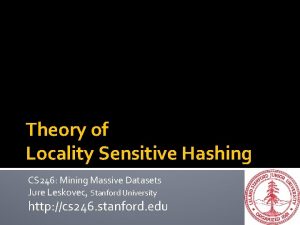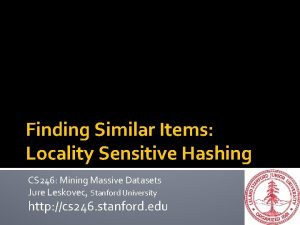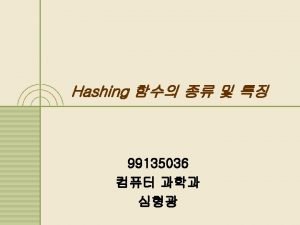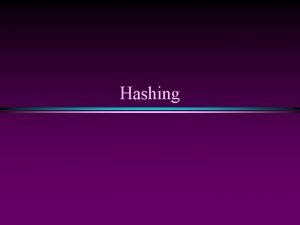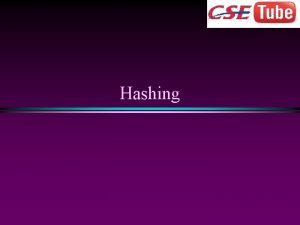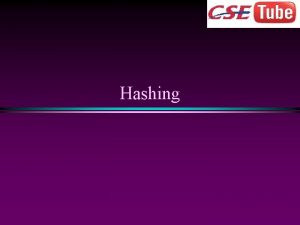Summer School on Hashing 14 Locality Sensitive Hashing




![Locality-Sensitive Hashing [Indyk-Motwani’ 98] q • p q “not-so-small” 1 Locality-Sensitive Hashing [Indyk-Motwani’ 98] q • p q “not-so-small” 1](https://slidetodoc.com/presentation_image_h/cf19b3c2600c5e0a2c985bca2760f1a8/image-5.jpg)





![NNS for Euclidean space [Datar-Immorlica-Indyk-Mirrokni’ 04] • 11 NNS for Euclidean space [Datar-Immorlica-Indyk-Mirrokni’ 04] • 11](https://slidetodoc.com/presentation_image_h/cf19b3c2600c5e0a2c985bca2760f1a8/image-11.jpg)
![Optimal* LSH [A-Indyk’ 06] • Regular grid → grid of balls p • p Optimal* LSH [A-Indyk’ 06] • Regular grid → grid of balls p • p](https://slidetodoc.com/presentation_image_h/cf19b3c2600c5e0a2c985bca2760f1a8/image-12.jpg)



![Time-Space Trade-offs space query Space time Time Comment Reference [Ind’ 01, Pan’ 06] low Time-Space Trade-offs space query Space time Time Comment Reference [Ind’ 01, Pan’ 06] low](https://slidetodoc.com/presentation_image_h/cf19b3c2600c5e0a2c985bca2760f1a8/image-16.jpg)

![Data-dependent Hashing! [A-Indyk-Nguyen-Razenshteyn’ 14] • 18 Data-dependent Hashing! [A-Indyk-Nguyen-Razenshteyn’ 14] • 18](https://slidetodoc.com/presentation_image_h/cf19b3c2600c5e0a2c985bca2760f1a8/image-18.jpg)
![A look at LSH lower bounds • [O’Donnell-Wu-Zhou’ 11] 19 A look at LSH lower bounds • [O’Donnell-Wu-Zhou’ 11] 19](https://slidetodoc.com/presentation_image_h/cf19b3c2600c5e0a2c985bca2760f1a8/image-19.jpg)











![Open question: • [Prob. needle of length 1 is not cut] ≥ 1/c 2 Open question: • [Prob. needle of length 1 is not cut] ≥ 1/c 2](https://slidetodoc.com/presentation_image_h/cf19b3c2600c5e0a2c985bca2760f1a8/image-31.jpg)
- Slides: 31

Summer School on Hashing’ 14 Locality Sensitive Hashing Alex Andoni (Microsoft Research)

Nearest Neighbor Search (NNS) •

Approximate NNS e t a im x o r • -a pp c r cr q p

Heuristic for Exact NNS e t a im x o r • -a pp c r cr q p
![LocalitySensitive Hashing IndykMotwani 98 q p q notsosmall 1 Locality-Sensitive Hashing [Indyk-Motwani’ 98] q • p q “not-so-small” 1](https://slidetodoc.com/presentation_image_h/cf19b3c2600c5e0a2c985bca2760f1a8/image-5.jpg)
Locality-Sensitive Hashing [Indyk-Motwani’ 98] q • p q “not-so-small” 1

Locality sensitive hash functions • 6

Full algorithm • 7

Analysis of LSH Scheme • collision probability distance 8

Analysis: Correctness • 9

Analysis: Runtime • 10
![NNS for Euclidean space DatarImmorlicaIndykMirrokni 04 11 NNS for Euclidean space [Datar-Immorlica-Indyk-Mirrokni’ 04] • 11](https://slidetodoc.com/presentation_image_h/cf19b3c2600c5e0a2c985bca2760f1a8/image-11.jpg)
NNS for Euclidean space [Datar-Immorlica-Indyk-Mirrokni’ 04] • 11
![Optimal LSH AIndyk 06 Regular grid grid of balls p p Optimal* LSH [A-Indyk’ 06] • Regular grid → grid of balls p • p](https://slidetodoc.com/presentation_image_h/cf19b3c2600c5e0a2c985bca2760f1a8/image-12.jpg)
Optimal* LSH [A-Indyk’ 06] • Regular grid → grid of balls p • p can hit empty space, so take more such grids until p is in a ball • Need (too) many grids of balls • Start by projecting in dimension t • Analysis gives • Choice of reduced dimension t? 2 D • Tradeoff between • # hash tables, n , and • Time to hash, t. O(t) • Total query time: dn 1/c 2+o(1) p Rt

p Proof idea • Claim: , i. e. , • P(r)=probability of collision when ||p-q||=r • Intuitive proof: Projection approx preserves distances [JL] P(r) = intersection / union P(r)≈random point u beyond the dashed line Fact (high dimensions): the x-coordinate of u has a nearly Gaussian distribution → P(r) exp(-A·r 2) • • qq r p P(r) u x

To Simons or not to Simons be not or Simons to • be not or Simons to LSH Zoo To be or not to be 1 … 01111… … 11101… 1 … 21102… … 01122… {be, not, or, to} {not, or, to, Simons} be to 14

LSH in the wild • fewer tables fewer false positives safety not guaranteed 15
![TimeSpace Tradeoffs space query Space time Time Comment Reference Ind 01 Pan 06 low Time-Space Trade-offs space query Space time Time Comment Reference [Ind’ 01, Pan’ 06] low](https://slidetodoc.com/presentation_image_h/cf19b3c2600c5e0a2c985bca2760f1a8/image-16.jpg)
Time-Space Trade-offs space query Space time Time Comment Reference [Ind’ 01, Pan’ 06] low high [AI’ 06] [IM’ 98] [DIIM’ 04, AI’ 06] medium [MNP’ 06, OWZ’ 11] ω(1) memory lookups [PTW’ 08, PTW’ 10] p oku o l m e 1 m high low ω(1) memory lookups [KOR’ 98, IM’ 98, Pan’ 06] [AIP’ 06]

LSH is tight… leave the rest to cell-probe lower bounds?
![Datadependent Hashing AIndykNguyenRazenshteyn 14 18 Data-dependent Hashing! [A-Indyk-Nguyen-Razenshteyn’ 14] • 18](https://slidetodoc.com/presentation_image_h/cf19b3c2600c5e0a2c985bca2760f1a8/image-18.jpg)
Data-dependent Hashing! [A-Indyk-Nguyen-Razenshteyn’ 14] • 18
![A look at LSH lower bounds ODonnellWuZhou 11 19 A look at LSH lower bounds • [O’Donnell-Wu-Zhou’ 11] 19](https://slidetodoc.com/presentation_image_h/cf19b3c2600c5e0a2c985bca2760f1a8/image-19.jpg)
A look at LSH lower bounds • [O’Donnell-Wu-Zhou’ 11] 19

Why not NNS lower bound? • 20

Intuition • 21

Nice Configuration: “sparsity” • 22

Reduction: into spherical LSH • 23

Two-level algorithm •

Details • Inside a bucket, need to ensure “sparse” case • 1) drop all “far pairs” • 2) find minimum enclosing ball (MEB) • 3) partition by “sparsity” (distance from center) 25

1) Far points • 26

2) Minimum Enclosing Ball • 27

3) Partition by “sparsity” • 28

Practice of NNS • Data-dependent partitions… • Practice: • Trees: kd-trees, quad-trees, ball-trees, rp-trees, PCA-trees, sp-trees… • often no guarantees • Theory? • assuming more about data: PCA-like algorithms “work” [Abdullah-A-Kannan. Krauthgamer’ 14] 29

Finale • 30
![Open question Prob needle of length 1 is not cut 1c 2 Open question: • [Prob. needle of length 1 is not cut] ≥ 1/c 2](https://slidetodoc.com/presentation_image_h/cf19b3c2600c5e0a2c985bca2760f1a8/image-31.jpg)
Open question: • [Prob. needle of length 1 is not cut] ≥ 1/c 2 [Prob needle of length c is not cut]
 Linear probing hash table
Linear probing hash table Distinguish between extendible and linear hashing
Distinguish between extendible and linear hashing Motivation for dynamic hashing
Motivation for dynamic hashing Static and dynamic hashing in dbms
Static and dynamic hashing in dbms Lodi summer school
Lodi summer school Crescenta valley high school graduation 2021
Crescenta valley high school graduation 2021 Assignment in spanish
Assignment in spanish Lru
Lru Locality of reference
Locality of reference Locality development model of community organization
Locality development model of community organization Locality of reference in os
Locality of reference in os Locality of reference in os
Locality of reference in os Spatial locality
Spatial locality This approximates a program's locality.
This approximates a program's locality. Found throughout the islands with little or no modification
Found throughout the islands with little or no modification Objectives of plastic bags
Objectives of plastic bags Good locality
Good locality Dependency locality theory
Dependency locality theory Locality principle in computer architecture
Locality principle in computer architecture Cache memory adalah
Cache memory adalah Locality of reference
Locality of reference Principle of locality
Principle of locality Sketch all serious crime and crash scenes:
Sketch all serious crime and crash scenes: Locality.org.uk
Locality.org.uk Charge sensitive preamplifier
Charge sensitive preamplifier Tiva
Tiva The development of children 7th edition
The development of children 7th edition Wiberg patella
Wiberg patella Disclaimer for sensitive content
Disclaimer for sensitive content Socially sensitive research meaning
Socially sensitive research meaning Nursing sensitive indicators
Nursing sensitive indicators Basic syntax of java
Basic syntax of java
